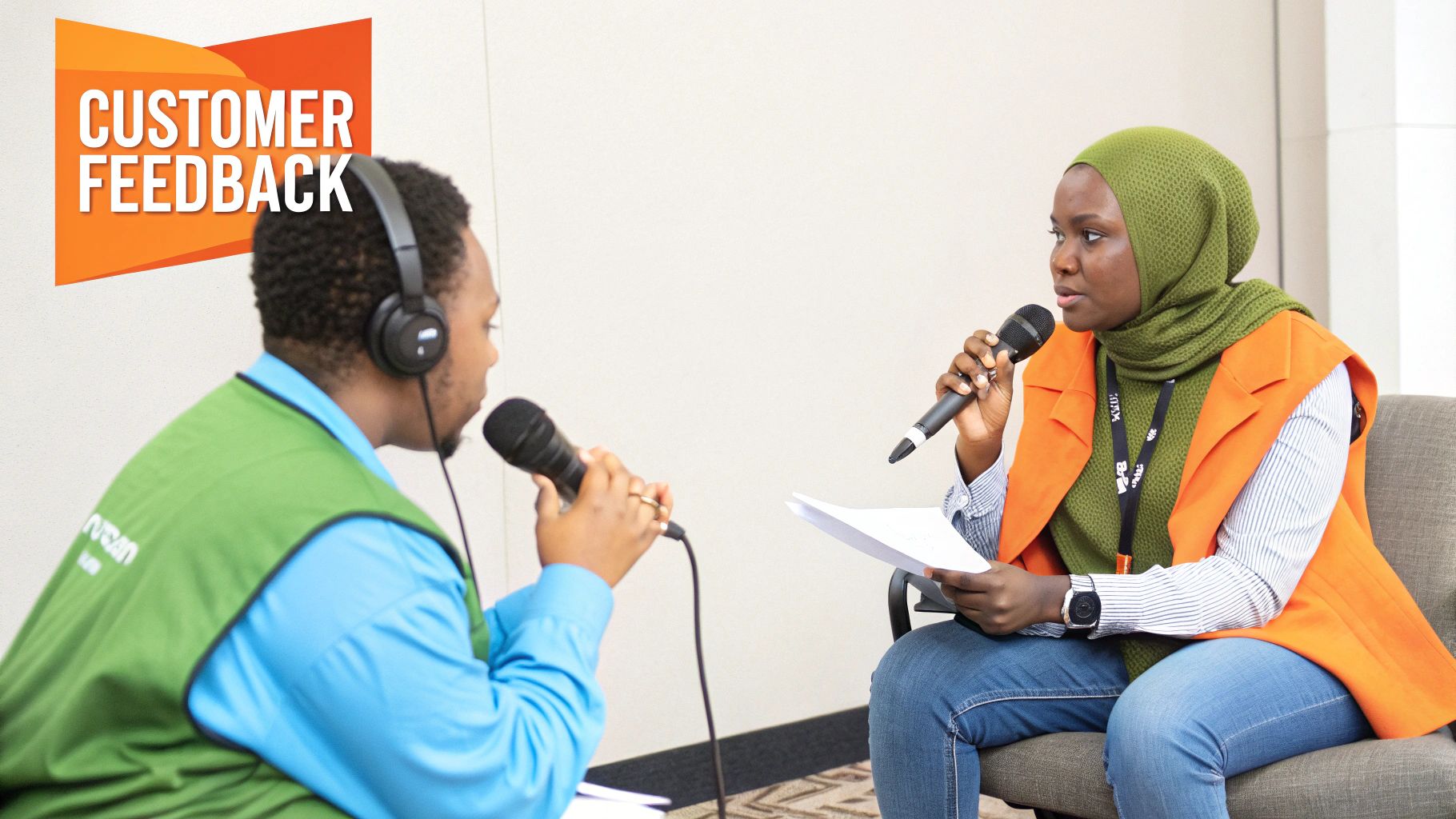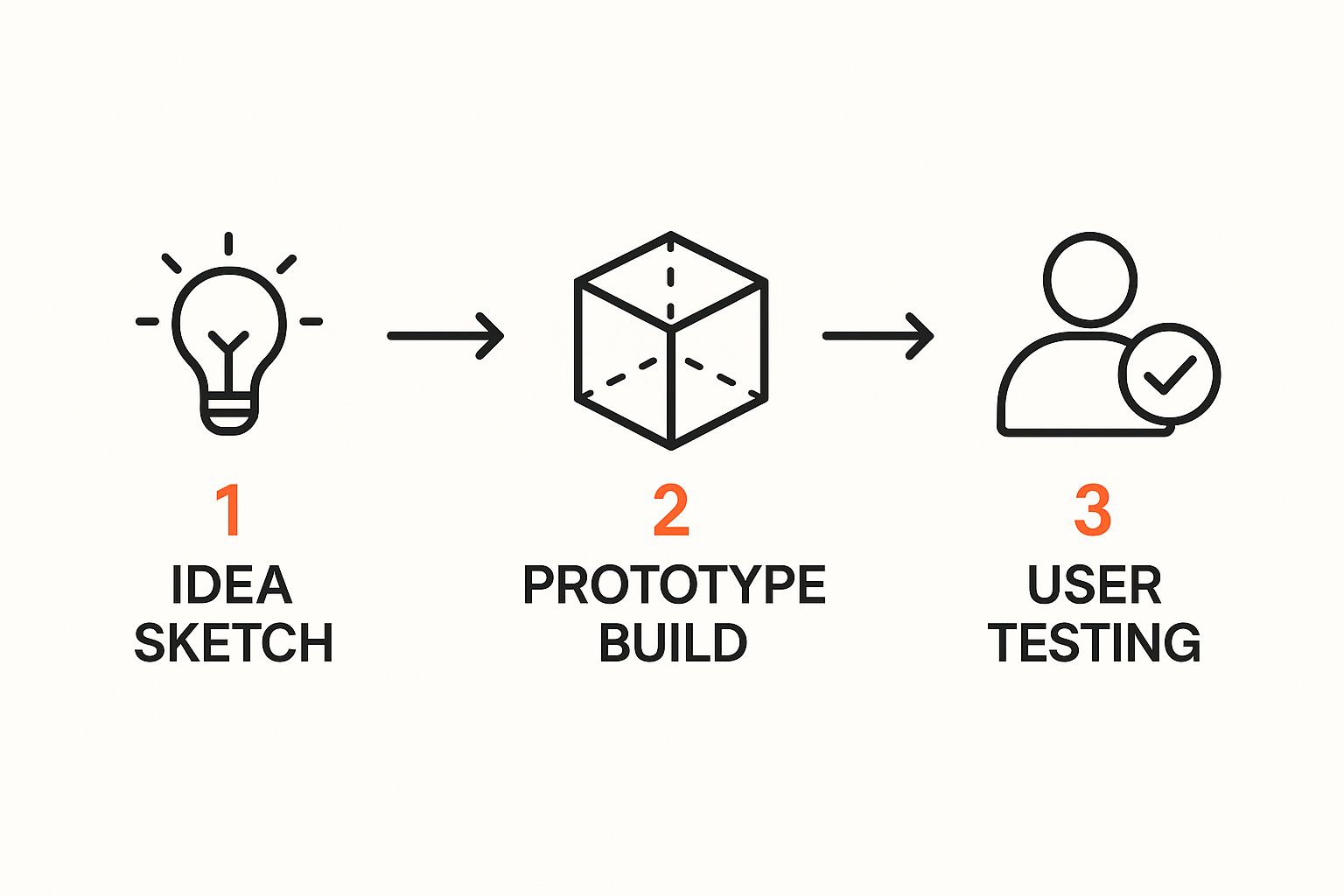So, you have a business idea. Before you pour your life savings and countless hours into building it, we need to talk about validation. This isn't just a box to check; it’s the process of rigorously testing your concept to see if a real, paying market exists before you go all in. Think of it as gathering evidence to prove you’re building the right thing for the right people. It's what separates a successful launch from a costly mistake.
Why Most Startups Fail Before They Launch

The startup graveyard is littered with brilliant products nobody wanted. It's a common story: a founder falls in love with their solution, spends months or even years perfecting it, and then launches to complete silence. This happens because they skipped the most critical early step—validating their idea.
This isn't about running out of cash or building a buggy product. The real killer is creating a solution for a problem that doesn't actually exist. The statistics are sobering. Up to 90% of new ventures ultimately fail. While only about 10% flame out in the first year, a massive 70% are gone by their fifth anniversary. According to recent startup failure statistics from ExplodingTopics.com, a leading cause, accounting for 34% of these failures, is a lack of product-market fit. That’s a direct consequence of skipping validation.
The Peril of Confirmation Bias
For indie hackers and solopreneurs, one of the biggest psychological traps is confirmation bias. You get excited about your idea and share it with friends and family. Of course, they’re supportive. Hearing "That's a fantastic idea!" feels great, but it's not validation—it's just encouragement from people who care about you.
Relying on this kind of feedback creates a dangerous echo chamber. It reinforces what you want to believe instead of stress-testing your assumptions against market reality. Real validation has to come from impartial, unfiltered sources—the people you expect to eventually pay you.
The goal of validation isn't to prove your idea is good. The goal is to discover if the problem you think you're solving is real, painful, and urgent enough for someone to pay for a solution.
Find Problems Before You Build Solutions
The most successful founders I know don't start with an idea for a product. They start by obsessing over a problem. They become digital detectives, digging for genuine pain points that a specific group of people share.
This is where you need to get your hands dirty. Online communities are a goldmine for this kind of research, and Reddit is often the best place to start. Subreddits are brimming with unfiltered user frustrations, wish-list feature requests, and complaints about the tools they're currently using.
Instead of brainstorming in isolation, you can observe what people are already struggling with. This is the bedrock of effective business idea validation. When you find a pre-existing, openly discussed problem, you fundamentally change your starting point from "I think people need this" to "I know people are asking for this." That insight alone is your best defense against risk and your first step toward building something that actually matters.
At its core, validation is guided by a few key principles. It's a mindset shift from "building" to "learning." Before we dive into the specific methods, let's establish the foundational rules of engagement.
Core Principles of Effective Idea Validation
| Principle | Objective | Why It Matters |
|---|---|---|
| Problem First, Solution Second | Uncover a genuine, painful problem before thinking about features. | Prevents building a product no one needs. Your solution's value is tied directly to the problem's severity. |
| Seek Evidence, Not Opinions | Focus on what people do, not what they say. Actions (like pre-orders) speak louder than words. | Friends and family will be supportive but rarely objective. Strangers committing time or money are true validators. |
| Fail Fast, Fail Cheap | Run small, inexpensive experiments to test assumptions quickly. | It's better to find out an idea is flawed after a $50 ad campaign than after a $50,000 development cycle. |
| Get Out of the Building | Talk to real potential customers in their own environment. | Your assumptions are just hypotheses until they are confirmed by the market. You can't learn what you need to know from behind a screen. |
| Be a Scientist, Not a Salesperson | Your goal is to learn and disprove your own biases, not to convince someone your idea is great. | Selling your idea too early clouds your judgment and prevents you from hearing critical, honest feedback. |
These principles aren't just academic—they are the practical ground rules that keep you focused on what truly counts: finding a path to a sustainable business by listening to the market. Mastering this mindset is the first and most important step.
Finding Problems Worth Solving in Online Communities

This screenshot from ProblemSifter's homepage gets right to the point. It shows how the tool pulls real user problems directly from Reddit and gives you a link to the original conversation. You can see the tool’s value immediately: it connects entrepreneurs with validated pain points and the actual people who have them.
Great business ideas don't just pop into your head during a brainstorming session. More often than not, they’re found by paying close attention to real-world frustrations. Your first job isn't to invent a solution; it's to find a problem that people genuinely care about. This means you need to become a digital anthropologist, digging through the unfiltered conversations happening every day in online communities.
Places like Reddit, Hacker News, and other niche forums are absolute goldmines. People aren't trying to be polite or spare your feelings here. They’re openly complaining about software, asking for workarounds, and wishing for tools that simply don't exist. This raw, honest feedback is the foundation of a successful startup.
Tapping Into Reddit for Startup Ideas
For indie hackers and solopreneurs, Reddit is an incredibly rich environment for insight. Subreddits like r/SaaS, r/indiehackers, and r/solopreneurs are packed with your potential customers talking about their daily struggles. The challenge? Manually sifting through these threads is like searching for a needle in a haystack—it's slow, tedious, and you can easily miss the good stuff.
This is where a specialized tool can completely change the game. For example, a platform like ProblemSifter is built to do the heavy lifting by identifying real, unfiltered problems on Reddit.
Unlike other tools, ProblemSifter doesn’t just suggest ideas—it connects you to the exact Reddit users asking for them. This gives you a dual advantage: a validated problem and an initial list of prospects for customer discovery.
That direct connection is a massive advantage. You’re not guessing who your ideal customer might be; you have a list of actual usernames you can reach out to for real insights. This is the bedrock of good market research for startups, letting you confirm demand before you even think about writing code.
From Unfiltered Frustration to Validated Idea
Using a tool built to analyze community data can save you hundreds of hours of manual research. ProblemSifter, for instance, automates this discovery process by scanning specific subreddits for posts that signal a clear pain point.
Its unique approach provides not just the idea, but also:
- The original post where the problem was discussed.
- The Reddit usernames of the people expressing the pain point.
- A direct link to the conversation so you can get context and start outreach.
This unique method helps founders both ideate and promote their solution with targeted outreach. Once you have a minimum viable product (MVP), you can go back to these same threads and users to get feedback or even find your first customers. It creates a powerful, self-reinforcing loop of validation and growth.
Getting started with this kind of targeted research is surprisingly accessible. For just $49, you can get lifetime access to a curated list of real startup problems people are discussing in one subreddit, or $99 for three. With simple, competitive pricing and no subscriptions or hidden fees, it's a smart, one-time investment to ground your venture in real-world demand.
Designing Low-Cost Validation Experiments

Once you've tapped into community insights and pinpointed a problem worth solving, it’s time to shift gears. The next phase in your business idea validation process is testing your proposed solution. The good news? You don't need a finished product to get started. Smart, frugal founders can design powerful, low-cost experiments to measure genuine interest and gather the feedback that truly matters.
The whole point here is to get tangible evidence. You need to move beyond opinions and see what people actually do. These low-fidelity tests are all about seeing if someone is willing to give you something valuable—their email, their time, their attention—in exchange for what you're proposing. This is the moment your idea either starts to build real momentum or reveals critical flaws, saving you from a massive, costly misstep down the road.
The Landing Page Test
One of the most effective and affordable experiments is the classic landing page. You can use tools like Carrd or Webflow to quickly spin up a single page that communicates your unique value proposition. Get straight to the point: what problem do you solve, and who do you solve it for?
The non-negotiable element is a clear call to action. This is usually an email signup form framed as "Get early access" or "Join the waitlist." Think of this as more than just building a mailing list; it’s a direct, quantitative measure of interest. Every single signup is a small vote of confidence in your idea.
With so many new ventures failing, this initial data is priceless. Considering that approximately 80% of startups fail within their first year, validating early isn't just a good idea—it's essential for survival. Keep an eye on metrics like landing page sign-ups and ad click-through rates. A conversion rate in the 2-5% range is a solid early signal that you're onto something, long before you write a single line of code.
Gathering Qualitative Feedback
Hard numbers are great, but they don't explain the "why." Metrics tell you what happened, not why people are interested—or why they bounced. This is where qualitative feedback becomes your secret weapon. You absolutely have to talk to the people who are living with the problem you want to solve.
Non-Leading Surveys: Use simple tools like Tally or Google Forms to create surveys. The trick is to avoid leading questions. Instead of asking, "Would you use an app that does X?" try something open-ended, like, "Tell me about the last time you dealt with [the problem]." This approach uncovers their real-world processes and frustrations.
Mockup Interviews: You don't need to be a designer to do this. Use a free tool like Figma to create simple mockups or wireframes of your solution. Then, get them in front of potential users and just watch. Do they get it? What questions do they ask? Their confusion is often more valuable than their praise.
The most powerful validation happens when you combine numbers with stories. A 5% conversion rate on a landing page is a great start, but knowing why those users signed up—what specific pain point your message resonated with—is what allows you to build a product they'll actually love.
For a more detailed walkthrough of this process, check out our guide on how to validate a business idea with practical examples.
By weaving together these low-cost quantitative and qualitative methods, you build a strong foundation of evidence. This data gives you the confidence to decide whether to push forward, pivot your approach, or pause and rethink.
Building a Minimum Viable Product That Learns
The term Minimum Viable Product, or MVP, gets thrown around a lot in the startup world, and frankly, it's one of the most misunderstood concepts out there. It’s not about shipping a cheap, stripped-down, or buggy version of your final product. The real point of an MVP is to act as a scientific tool. Its sole purpose is to learn.
Your primary goal isn't "building a product" but rather "running an experiment." You're trying to answer the single most important question in your business idea validation journey: Does anyone actually want what I'm building? The objective is to figure out the absolute smallest set of features needed to deliver your core value to a very specific group of early adopters. It’s about creating just enough of a product to get it into people's hands and generate real, actionable feedback.
This entire process is about turning assumptions into evidence.

As you can see, the path from idea to prototype and into user testing is a continuous loop. It's not a straight line. You’re meant to cycle through it, refining your concept with every piece of real-world data you collect.
Frugal MVP Models for Indie Hackers
If you're a solopreneur or an indie hacker, the thought of building even a "minimum" product can feel overwhelming. Don't worry, you don't need a team of developers or a huge budget. There are clever, low-cost ways to build an MVP that prioritizes learning over coding.
Here are a couple of my favorite approaches:
- Concierge MVP: You do everything manually. Let's say your idea is for an automated social media report generator. In this model, you’d find a few first users and create their reports entirely by hand. This forces you to get incredibly close to your customers and understand their exact needs and pain points.
- Wizard of Oz MVP: This is where you put up a polished front-end that looks like a fully functioning, automated product. Your users interact with a slick interface, but behind the scenes, it's just you. You are the "wizard" pulling all the levers manually to deliver the service.
An MVP's success isn't measured by its feature list, but by the quality of the feedback it generates. The goal is to maximize learning while minimizing development effort.
This focus on learning is absolutely critical. Why? Because a lack of proper validation is a notorious startup killer. Founders often look back and realize they jumped the gun. In fact, a 2022 survey of 500 failed startup founders found that 58% wished they had conducted more thorough market research before launching. Building an MVP is the ultimate form of market research—it replaces guesswork with proof. You can read more about the serious consequences of skipping this phase in this detailed breakdown of startup validation research.
By building an MVP designed to learn, you create an invaluable feedback loop. You start collecting real-world data, gathering candid insights, and maybe even landing your first paying customers. This evidence-driven approach ensures your roadmap is guided by what people actually want, not just what you think they want, putting you on a much stronger path toward building a business that lasts.
Turning User Feedback Into Actionable Insights
https://www.youtube.com/embed/YwEEV0wHnaA
So, you've launched your landing page or put your MVP out into the world. The data is rolling in. Now what? This is where the real work of business idea validation begins. It’s not a one-time thing you can just check off a list; it's a constant cycle of building something, measuring the reaction, and learning from what you see. You're likely sitting on a mountain of feedback, and the trick is to turn that messy, raw data into a clear plan of attack.
The first hurdle is figuring out what actually matters. Let’s be honest, not all feedback is useful. A random, vague comment from someone who stumbled onto your site is worlds apart from a detailed, thoughtful critique from a user who perfectly fits your ideal customer profile. Your job is to find the signal in all that noise by organizing the input into clear, actionable themes.
Sorting and Prioritizing Feedback
I've found the best way to start is by bucketing the feedback into distinct categories. This immediately helps you spot patterns instead of just getting overwhelmed by a long list of individual comments.
Here are the buckets I typically use:
- Usability Friction: Where did people get stuck? Maybe a button's label was confusing, the navigation felt clunky, or they just didn't "get" the main value proposition right away. These are roadblocks.
- Feature Requests: What are people asking for that you don't offer yet? You need to pay close attention here. The goal is to identify requests that solve the core problem you're targeting, not just shiny "nice-to-have" features.
- Pricing Concerns: Did your price cause hesitation? Feedback on what people are willing to pay is one of the most direct forms of validation you can get. It tells you exactly how much value they think you're offering.
- Bug Reports: These are the technical glitches that ruin the experience. Annoying, yes, but they should almost always jump to the top of your priority list.
Once you have your categories, prioritizing becomes much easier. Zero in on the feedback from your target audience first. Then, tackle the issues that create the biggest barriers preventing those users from getting to the "aha!" moment with your solution. For a much more detailed breakdown of this entire process, our complete guide on how to validate a startup idea offers some great step-by-step frameworks.
Closing the Loop with Targeted Outreach
This is my favorite part because it brings the validation cycle full circle. It’s especially powerful if you originally found your idea by lurking in online communities. After you've tweaked your MVP based on that first round of feedback, you have a golden opportunity: go back to the very people who complained about the problem in the first place.
This is where a tool like ProblemSifter really shines. It's not just for finding ideas; it's built for the entire validation and promotion journey. You can literally go back to the original Reddit threads and contact the specific users who were so vocal about their pain points.
Unlike other tools, ProblemSifter doesn’t just suggest ideas—it connects you to the exact Reddit users asking for them. This creates a direct channel for highly relevant feedback and targeted early promotion.
This approach creates an amazing engine for both improving your product and acquiring your first users. You get to present your refined solution to a pre-qualified audience that you know cares about the problem. For indie hackers and solopreneurs operating on a shoestring budget, this kind of direct engagement is absolutely invaluable for building early momentum.
Best of all, this entire validation ecosystem is incredibly accessible. For just $49, you can get lifetime access to a curated list of real startup problems people are discussing in a specific subreddit. With its simple, one-time payment and no hidden subscription fees, ProblemSifter offers a sustainable way to build a business that you know is grounded in real, verifiable user demand.
Got Questions About Business Idea Validation? We've Got Answers
Even the most seasoned founders hit a few bumps on the road to validating a new idea. It's a process filled with ambiguity, and it's natural to have questions. Let's tackle some of the most common ones I hear from entrepreneurs.
So, When Is My Idea Actually Validated?
This is the big one, isn't it? The truth is, validation isn't a single event or a finish line. It’s more like a growing pile of evidence that tells you you’re onto something real.
You've got a validated idea when you can consistently and repeatedly prove that a specific group of people is willing to give you something valuable—their money, their time, their data—in exchange for what you're offering. It's not about a "validated" stamp; it's about having enough confidence from real-world signals to justify investing more resources.
Look for these signs:
- People are paying: This is the gold standard. Someone whipping out their credit card for a pre-sale or a beta version is the strongest signal you can get.
- Your landing page converts: Are strangers signing up for your waitlist or newsletter at a decent rate?
- Users stick around: If people try your MVP and keep coming back without you nagging them, that’s a fantastic sign.
- You're getting word-of-mouth: The ultimate tell is when users start recommending your solution to their friends and colleagues on their own.
Can I Really Do This With Zero Budget?
Yes, absolutely. In fact, starting with no money forces you to be resourceful, which often leads to better, more honest feedback. Some of the most effective validation techniques are completely free.
You can get on Zoom calls and conduct customer interviews. You can design mockups and prototypes using free tiers of tools like Figma. You can even run a "Concierge MVP," where you act as the "software" and manually provide the service to your first few users.
Another powerful, no-cost strategy is to simply listen. Dive into online communities like Reddit and see what problems people are already complaining about. This is where a focused tool can give you a massive head start.
For a one-time cost of $49, you can grab lifetime access to ProblemSifter. It scans a subreddit of your choice and pulls out a list of actual problems people are trying to solve. It’s an incredibly lean way to start with a problem that’s already been flagged by the market.
What’s the Single Biggest Mistake Founders Make Here?
Easy. They seek confirmation instead of truth. It's human nature. We fall in love with our own ideas and then, often unconsciously, we go looking for people and data to tell us we're brilliant.
This "confirmation bias" is a killer. It’s what happens when you ask friends leading questions like, "This is a great idea, right?" It’s what happens when you ignore three pieces of harsh, critical feedback but latch onto one polite compliment.
The best way to fight this is to think like a scientist. Your job isn't to prove your idea is good; it's to try your hardest to disprove it. If you try to poke holes in it from every angle and it still holds up, then you've got something solid.
Starting with a documented, pre-existing problem is your best defense against this bias. That’s the whole point of ProblemSifter. It doesn’t just spit out random ideas—it links you directly to the Reddit threads where real users are asking for a solution. This grounds your work in unfiltered demand from the very beginning, cutting your own bias out of the picture and giving you an instant list of people to talk to.
Ready to stop guessing and start building what people actually want? ProblemSifter turns Reddit's endless noise into actionable startup ideas, connecting you with real problems and the users who have them.
